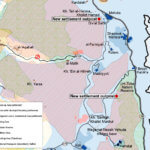Senior IDF officer admits ‘live-fire zones’ used to expel Palestinians in the West Bank
This article was first published in Middle East Monitor on 21st May 2014
A senior IDF officer has told a Knesset committee that military training in live-fire zones in the West Bank “is used as a way of reducing the number of Palestinians living nearby, and serves as an important part of the campaign against Palestinian illegal construction”, according to a report in Israeli daily Haaretz.
Col. Einav Shalev also described the IDF’s policy of confiscating humanitarian equipment destined for Palestinians whose homes have been destroyed as “a punch in the right places”. Shalev made the remarks during a session of the ‘Judea and Samaria Affairs’ subcommittee of the Foreign Affairs and Defense Committee on 27 April.
Those in attendance at the subcommittee hearing included Jewish Home MKs Mordechai Yogev and Orit Strock (both residents of West Bank settlements), Separation Wall route-planner and leading settler Danny Tirza, as well as representatives of the Israel Police, Interior Ministry, Foreign Ministry, and Housing Ministry.
Haaretz correspondent Amira Hass relates how the meeting discussed “ways of expelling Palestinian residents from areas such as E1, the Jordan Valley and Susya, south of Hebron.” Another participant, coordinator of government activities in the territories Gen. Yoav Mordechai, said Israeli authorities are focused “on the removal of Bedouin from the [E1] area”, while also finding time to praise the work of Regavim, a hard-right Zionist NGO targeting Palestinian construction.
Mordechai, as a previous report on the meeting noted, admitted that “master construction plans for the Palestinian populations have been frozen as a response to Mahmoud Abbas overtures to the UN organizations”.
The committee also got drawn into a bizarre discussion about the apparent differences between ‘Arabs’, ‘Bedouin’ and ‘Palestinians’, with MK Strock asking Gen. Mordechai “Do you verify that the Bedouin are actually Bedouin and not just Arabs?” The general said that Israeli authorities are “mapping all the Bedouin tribes very precisely” – but Strock concluded: “I call them just Arabs”.
MK Yogev told the committee that he has raised the ethnic cleansing of Palestinians from sections of the West Bank “to the top of the order of priorities”, because “there is a difference between an Arab who has a house in Yatta or Tubas and should be kicked back to there and an Arab who, if you throw him out he will go to the closest wadi”.
18 percent of the West Bank is defined as closed military areas designated for military training, an area that includes more than 6,000 Palestinians in 38 communities. “Most of the communities have been in existence since long before Israel conquered the West Bank in 1967, and certainly before the areas were designated live-fire zones”, the paper notes.



